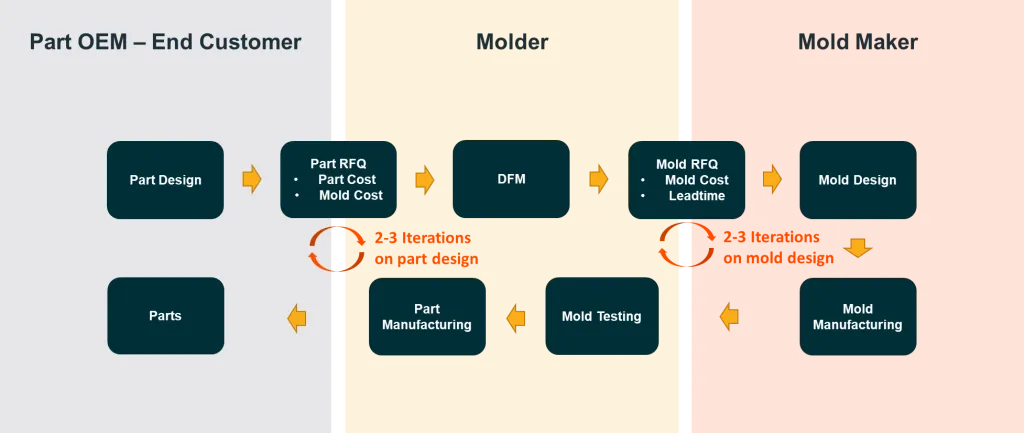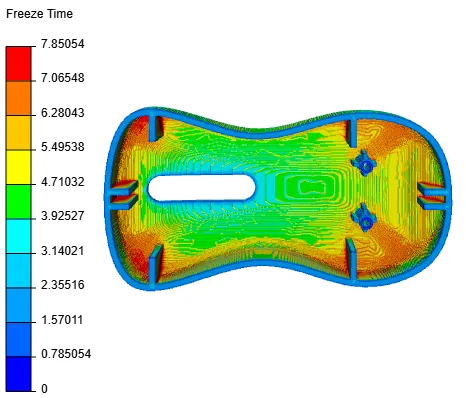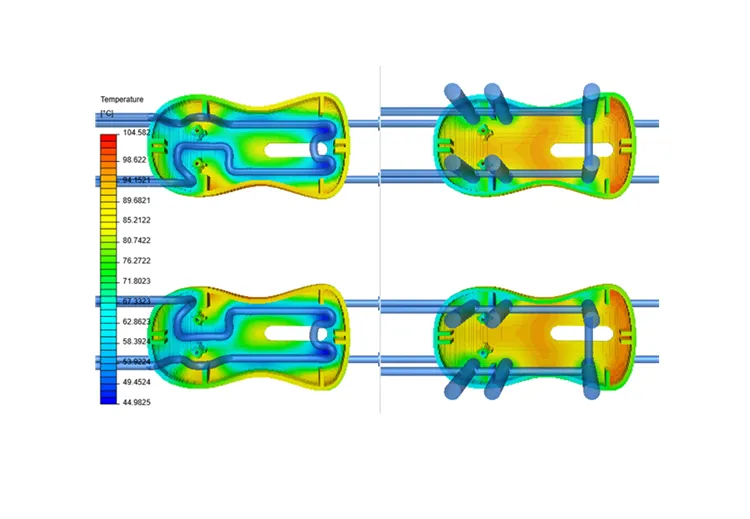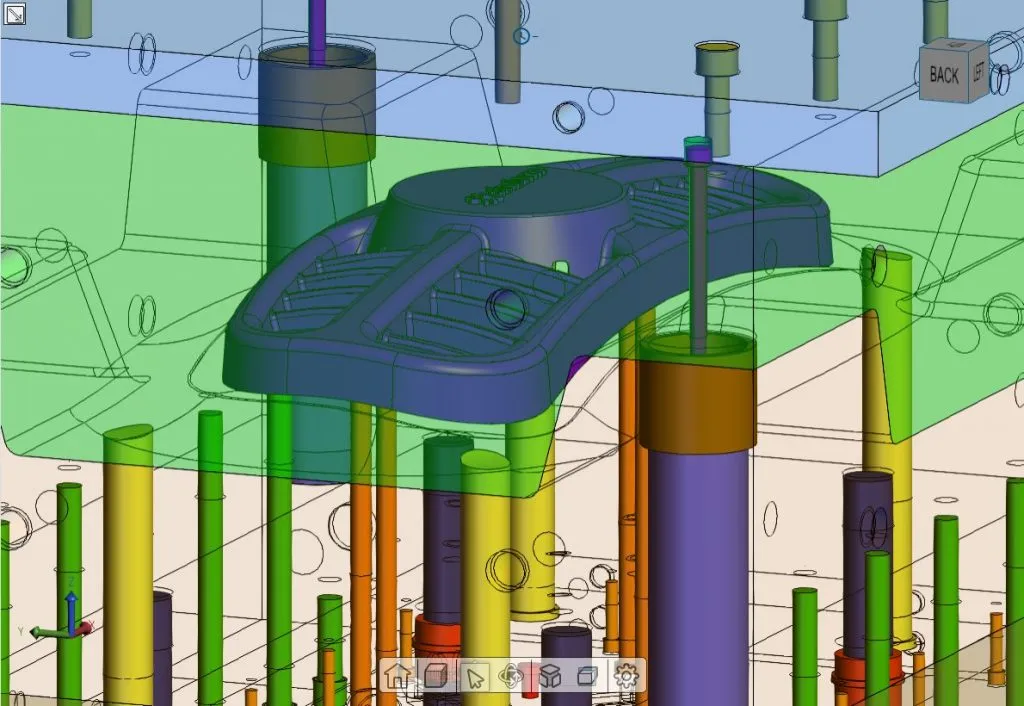by Arnaud Divialle
In this second of two blog posts, we continue with our narrative from tool design to delivery. We’ll cover the final four phases leading up to mold delivery, and how front-end thermal simulation with SimForm improves plastic injection mold design workflows at each stage. (Read Part 1 here).
To illustrate the role SimForm can play improving how molders (“Ken”) and mold makers (“Danny” and “Bob”) collaborate, we compare two workflows:
- The Standard Workflow of the industry today, based on more than 50 interviews over the past two years of industry players at every level; and
- The SimForm Workflow, which introduces front-end thermal simulation into the plastic injection molding process before the mold design is complete.
At this stage, the mold maker’s designer Danny has completed a detailed design.

4. Design optimization
Standard Workflow: Danny proceeds to add more details to the plastic injection mold design. At this point, Bob and his engineering manager also get involved to ensure the mold is neither over-designed, which would reduce their profit margins, nor under-designed, which could require additional iterations. But without data to support their decisions, multiple design reviews between Danny and Ken are a common headache. Each side argues for changes based on gut feelings or past experience, which can make it difficult to align on a direction and often leads to delays, added cost, and compromised outcomes.

SimForm Workflow: Using SimForm, Danny is able to improve his mold thermal performances in multiple ways:
- cooling uniformity (avoiding hot spots)
- cooling performances (controlled temperature increases between inlet & outlet)
- cooling time (to feed cycle time estimation)
Danny and Ken perform “what if” scenarios to quantify the impacts of various design decisions, such as adding bubblers or baffles, using MoldMax for inserts, the potential benefit of jump lines or conformal cooling for the channels, all of which help him build business cases for the molder. It also could enable the mold designer to build and sell more expensive molds.
Bob can also use SimForm to challenge his designers, thereby reducing development cost and risk, while making sure the mold will meet the molder’s requirements.
5. Mold verification with full simulation
Standard Workflow: To verify the mold using a full simulation—usually at the request of their client, the molder (Ken)—Danny’s project manager Bob may choose to send it to a group within his company, or outsource it to a third-party supplier. This step can cost $2000 (U.S.), and add one week or more to the project. This verification may identify unforeseen hot spots or risk of warpage, which leads to further design iterations, adding cost and time. On average, two to three iterations occur between design and simulation before a mold is approved for manufacturing.

SimForm Workflow: Due to thermal simulations already performed in-house, a full mold flow simulation holds much less risk of identifying defects or weaknesses in the design, and reduces the number of design iterations (saving time and cost).
6. Mold manufacturing
Standard Workflow: Bob begins manufacturing the mold, either after the results from the mold verification simulation, which may have added delays, or in parallel to the mold verification simulation, which risks a design defect getting missed. That could be disastrous, as injection molding can cost as much as $10,000—$100,000 or even more to set up, depending on order size, part complexity, and other factors. Flaws and defects found too late are costly to go back and change.

SimForm Workflow: Early thermal simulations have reduced the likelihood of finding additional problems, making it less risky for Bob to start manufacturing in parallel to mold verification simulation, and reducing time to market. In addition, early rapid iterations can produce simpler mold designs that only use cooling lines where actually necessary, which create molds that are faster and less costly to manufacture.
7. Mold setup and delivery
Standard Workflow: Ken and his team prepare to verify the performances of the design and manufacturing quality of the mold, a process that can take several days. The manufacturing parameters are typically based on the results of the mold verification simulation, or otherwise based on experience. Nonetheless, the mold setup still sometimes reveals that the committed cycle time can’t be reached with the existing mold. If this happens, Ken needs the plastic injection mold tooling changed, at additional cost and delays, in order to meet production cost targets. A worst-case scenario: Ken has to go back to his OEM customer to request a price change to the part, undermining his firm’s credibility and damaging its reputation.

SimForm Workflow: By this point, the risk of any discrepancy in the cooling time is much lower for Ken, reducing the potential for costly delays. The “what if” scenarios enabled Ken, with his mold maker, to explore different manufacturing parameters, including flow rate and coolant temperature, which reduced test duration and helped production start sooner.
Confidently accelerate time to market
Everyone is ultimately aimed at the same goal: getting the plastic molded parts to market. The OEM will be focused tightly on the bottom line, and even small percentages of difference for lead time, manufacturing efficiency, or cycle times can have a huge impact. Even if production efficiency is at 103%, for example, inefficient tools that create a material scrap rate of 10% would mean a final yield of only 93% — a clear indication that the production system has failed.
The entire process from mold design to delivery can take several weeks, and molders like Ken bear significant risk in how they quote prices to OEMs. Accuracy is important to both Ken and to the OEM who will use the molds.
By utilizing SimForm throughout multiple stages of mold development, mold designers can dramatically streamline collaboration and the iterative process, and provide molders with a higher degree of cost certainty that can be a competitive advantage for molders and mold designers alike.
Here’s a brief recap of the benefits SimForm provides at each stage:
- Quoting: Improves part design and production cost
- Part design: Reduces design iterations with objective and quantified results; supports specific and tangible DFM (Design for Manufacturability) recommendations; enables a shorter time to market
- Mold design: optimizes cooling strategies; reduces guesswork, development time and cost, especially on complex plastic injection molding designs
- Design optimization: Improves mold thermal performances in cooling uniformity, cooling performances, and cooling time; running “what if” scenarios quantify the impacts of various design decisions
- Mold verification: Reduces the risk that a full mold flow simulation will identify defects that need to be addressed
- Mold manufacturing: Lowers the risk of any discrepancy in the cooling time and the potential for costly delays
- Mold set-up and delivery: “What if” scenarios explore different manufacturing parameters that reduce test duration and help production start sooner
Discover the benefits of early and rapid thermal simulation. Get your free trial of SimForm today.